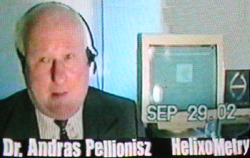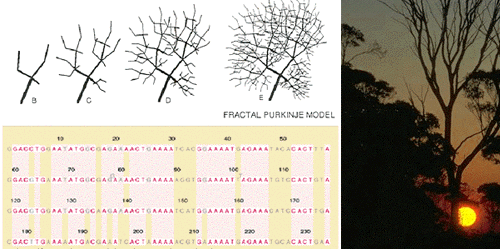PRESS AND TELEVISION COVERAGE (SEE AT BOTTOM) ON FRACTAL DNA PATENT PENDING
"If the claims made by the accomplished biophysicist Andras Pellionisz hold any water, life's blueprints may indeed be in fractal patterns found in the DNA. In a human, genes constitute only around 2-3% of the total DNA (the exons). The rest of the non-genic DNA (called introns) play a role that has not yet been understood and some have even suggested that these may merely be evolutionary leftovers. Removal of this "junk-DNA", however, has been proven to be lethal. The introns, he claims, may have the "building construction blueprints" in the form of fractal patterns that the exons use to build living tissue. A patent application covering attempts to count, measure and compare the fractal properties of introns for diagnostic and therapeutic purposes has been made. He hopes his patent will help him launch his company and make it a key player in this field." (Slashdot.org)
PRESS ON BIOTECHNOLOGY FUNDS
J.P. Morgan Closes $7.7 Billion Fund
December 3, 2002
The private equity arm of J.P. Morgan Chase & Co., J.P. Morgan Partners, has closed a $7.7 billion fund, the largest private equity fund raised to date...
The new investment vehicle, which was raised over a two-year period by an internal team that involved the participation of J.P. Morgan Securities Inc., includes $1.7 billion in funds from major institutional investors, among them Caisse de dépôt et placement du Québec, CalPERS, New York State Common Retirement Fund and the State of Michigan Retirement Fund, as well as from high-net-worth individuals. J.P. Morgan said it will invest up to $4 for every dollar of outside money that has been invested...
This is a difficult market in which to raise a multibillion-dollar fund and it will be much more difficult to raise such funds moving forward, but they [J.P. Morgan] have a unique franchise and a team with the right breadth and depth of experience that allows them to offer this type of broad-ranging product, said Erik Hirsch, chief investment officer at Hamilton Lane, a Bala Cynwyd, Pa., based consulting firm to large pension funds.
Since the tech and telecom downturn, general partners in PE or VC funds have been more amenable to investing in highly focused funds that have demonstrated success in a specific segment of the market, such as biotechnology or specifically buyout deals.
Information-based medicine holds great promise
Dec 3, 2002
By Caroline Kovac, general manager of IBM Life Sciences.
ARMONK, N.Y. (CBS.MW) -- We are at the start of a revolution. Its impact on humanity will be as significant as the Internet or the Industrial Revolution. What's happening is the marriage of information technology and medicine into the emerging field of information-based medicine. It holds the promise of forever changing the way medical care is delivered.
The goal of information-based medicine is, quite simply, to achieve a very personal level of medical care. In patient terms, this means more precise diagnoses and individualized treatment options. Doctors will be able to routinely supplement traditional diagnostic procedures with new knowledge, ranging from information on a patient's unique genetic characteristics and family history to needed clinical and lab tests to collective knowledge about treatment outcomes from studies of large patient populations.
New discoveries about the human genome coupled with the convergence of technology at every stage of the drug development process are at the heart of information-based medicine. New technologies such as transcription profiling, micro arrays, DNA chips, and mass spectrometry are generating massive amounts of data about genes and proteins that could shed light on the origin, prevention and cure of many diseases such as cancer, diabetes, Alzheimer's and heart disease. In order to effectively "mine" this new data, powerful computing systems are required to access, analyze and manage this information, enabling collaboration among researchers around the world.
Major medical institutions, such as the Mayo Clinic and the Winship Cancer Institute at Emory University, are among the early adopters of information-based medicine. The Mayo Clinic, in collaboration with IBM, is putting six million medical records -- data collected from informed, consenting patients -- into an advanced data management system. When fully operational, this system will be a comprehensive source for physicians and researchers to understand how a patient's genetic makeup can influence the course of a disease and will offer comparative perspectives on large patient populations. It will also offer Mayo Clinic researchers to quickly identify the best candidates for clinical trials in order to offer new breakthroughs in patient treatment.
At Winship Cancer Institute at Emory University, a project is underway to develop an information system that will help doctors tailor cancer treatments based on a patient's genetic makeup. The system is designed to provide sophisticated analyses such as gene expression, which shows the genes that are switched on or off in a disease state. Winship investigators can gather important information from these studies regarding how a patient will respond to a particular drug therapy.
Protecting patient privacy and confidentiality are important practices that will be essential to ensure the success and adoption of information-based medicine. Mayo Clinic and Winship Cancer Institute of Emory University are already addressing the issues of privacy and confidentiality of patients' records. They are incorporating technologies and featuring multiple levels of security to protect patient data and keep personal identities protected.
Looking ahead, the wave of discovery around the human genome and subsequent research will bring significant business value to pharmaceutical and biotechnology companies, which are under increasing pressure to design better drugs and get them to the market faster. According to a 2001 Tufts University study, it now costs an estimated $800 million to discover and develop a new drug, two and a half times the cost in 1987. Further, it can take up to 15 years for a new drug to reach the market. Last year, the pharmaceutical industry got FDA approval to market 24 new drugs in the U.S., half the number that were introduced in 1996.
Advanced information technology can play a key role in improving drug discovery and development by helping drug makers rapidly identify new chemical compounds and improve efficiency throughout each phase of the drug discovery process. It can also help automate the clinical trial process of testing and reporting to the U.S. Food & Drug Administration on the safety and effectiveness of new drug targets, and even identify drug failures faster.
The pharmaceutical industry is also beginning to see early successes with gene-based drug development. To build on this success, the identification of gene and protein targets is essential. Companies, such as San Diego-based GeneFormatics, Inc., are focused on rapidly discovering the functions and structures of human proteins that may be associated with various diseases. This research will help to identify and prioritize potential protein targets to create new drugs.
While information-based medicine is a new phenomenon, its roots are solidly planted in the computing technology that has supported businesses around the world for the last 40 years. Pioneering work is underway in systems modeling, which uses computer technology to model not just the functions of individual genes and proteins, but their complex interactions within a cell, tissue, organ or whole organism. Systems modeling draws on the experiences gleaned from aerospace and other industries in engineering design.
Who would have ever thought that an airplane like the Boeing 777 could be designed completely by computer simulation? Imagine virtually designing a plane and viewing it from every angle -- from electrical systems to stress factors in the wings -- without the need for a prototype airplane. The first Boeing 777 ever built flew with test pilots, eliminating the countless steps and expenses required with models and prototypes. This represented a significant milestone in aviation industry.
Similarly, researchers at the Institute of Systems Biology, Physiome Sciences, and Structural Bioinformatics, are using system modeling to simulate how genes and proteins interact in networks. Structural Bioinformatics, another San Diego company, maintains some of the world's largest proprietary databases of atomic-resolution 3-D protein structures, which are being used by pharmaceutical researchers to design molecules that interact with disease proteins. These models bring important insights into how individual patients will respond to drug therapies. Knowing in advance if a patient will be helped by a specific drug can mean the difference between life and death.
The advent of information-based medicine will not only help change the way medicine is practiced, but will also have a profound impact on keeping people healthy in the future. For example, pre-symptomatic testing will become more common enabling doctors to predict the likelihood of patients' risk for certain diseases, allowing for early preventive care.
We have a lot to look forward to. At the turn of 20th century, the average life expectancy for an American male was less than 50 years old. Today, the average life span has increased to 78 years, largely because of the development of vaccines against infectious diseases, such as smallpox, and other medical advances such as antibiotics. It is possible that the next generation of Americans can expect to live to be 100 years or older. The future of information-based medicine holds so much promise for living longer, healthier lives. And the bottom line is, this is just the beginning of the revolution.
TELEVISION COVERAGE ON FRACTOGENE PATENT PENDING OF HELIXOMETRY
Magyar TV (két interjú) Pellionisz-t ismerők és/vagy Helixometry iránt érdeklődők számára máris elérhető
Full English Video of two TV interviews on HelixoMetry / Fractogene, is available upon request
Excerpt only:
Soros-Perseus Biotech Fund: Pellionisz quotes financing "N-Gene"
 (If not installed yet in your computer, download Quicktime from here to play above 3 Mb clip)
(If not installed yet in your computer, download Quicktime from here to play above 3 Mb clip)
Intellectual Capital FractoGene, the Fractal Language of genetic code (US patent pending).
Interview with founder of HelixoMetry, a California Corporation
Self-similar DNA basepair-strings determine Stem, and B-E fractal growth ~~~ Real forest? Fractal classic?
contact info:
Dr. Andras J. Pellionisz
cob@helixometry.com
cell (408) 891-7187


